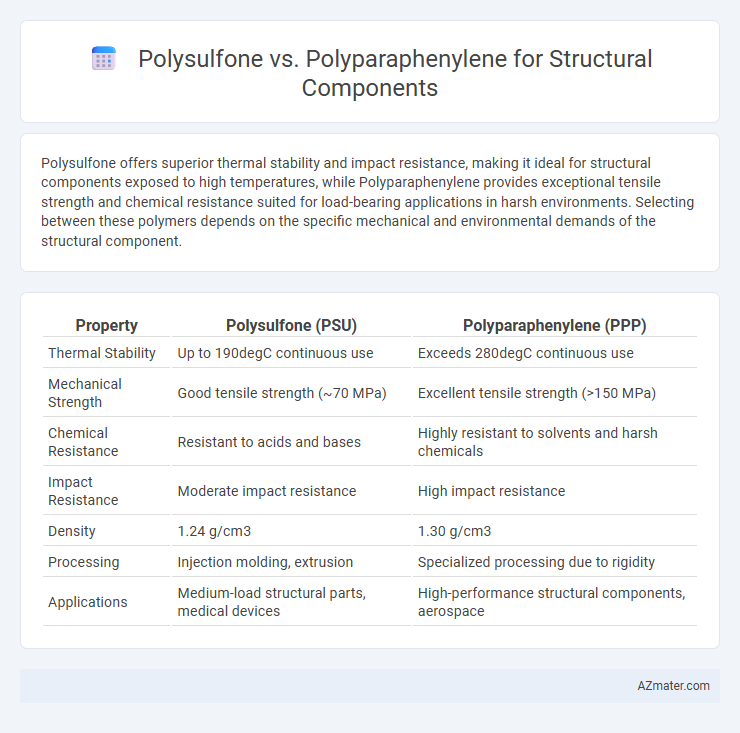Polysulfone offers superior thermal stability and impact resistance, making it ideal for structural components exposed to high temperatures, while Polyparaphenylene provides exceptional tensile strength and chemical resistance suited for load-bearing applications in harsh environments. Selecting between these polymers depends on the specific mechanical and environmental demands of the structural component.
Table of Comparison
| Property | Polysulfone (PSU) | Polyparaphenylene (PPP) |
|---|---|---|
| Thermal Stability | Up to 190degC continuous use | Exceeds 280degC continuous use |
| Mechanical Strength | Good tensile strength (~70 MPa) | Excellent tensile strength (>150 MPa) |
| Chemical Resistance | Resistant to acids and bases | Highly resistant to solvents and harsh chemicals |
| Impact Resistance | Moderate impact resistance | High impact resistance |
| Density | 1.24 g/cm3 | 1.30 g/cm3 |
| Processing | Injection molding, extrusion | Specialized processing due to rigidity |
| Applications | Medium-load structural parts, medical devices | High-performance structural components, aerospace |
Introduction to Polysulfone and Polyparaphenylene
Polysulfone is a high-performance thermoplastic known for its excellent thermal stability, mechanical strength, and chemical resistance, making it suitable for demanding structural components in aerospace and automotive industries. Polyparaphenylene, an aromatic polymer characterized by its rigid backbone and outstanding tensile strength, offers exceptional electrical conductivity and thermal resistance, advantageous for structural applications requiring durability and performance under extreme conditions. Comparing these materials hinges on balancing polysulfone's versatility and processability against polyparaphenylene's superior mechanical properties and thermal endurance for optimized structural component design.
Chemical Structure Comparison
Polysulfone features a backbone with aromatic rings linked by sulfone (-SO2-) groups, providing high thermal stability and chemical resistance essential for structural components. Polyparaphenylene consists of para-linked benzene rings forming a rigid, linear, and highly conjugated structure that delivers exceptional mechanical strength and stiffness. The sulfone linkages in polysulfone enhance flexibility and processability compared to the more brittle but stronger polyparaphenylene, influencing material selection based on application-specific mechanical and thermal requirements.
Mechanical Strength and Performance
Polysulfone exhibits high mechanical strength with excellent impact resistance and dimensional stability, making it suitable for various structural applications requiring durability under stress. Polyparaphenylene surpasses polysulfone in tensile strength and thermal stability, providing superior performance in extreme temperature environments and high-load mechanical components. When balancing cost and mechanical performance, polysulfone offers versatility, while polyparaphenylene is preferred for advanced structural components demanding exceptional strength and thermal resistance.
Thermal Stability Differences
Polysulfone exhibits excellent thermal stability with a high glass transition temperature around 185degC, making it suitable for structural components exposed to moderate heat. Polyparaphenylene, specifically in its fully aromatic form, offers superior thermal stability often exceeding 400degC, enabling it to withstand extreme thermal conditions in advanced engineering applications. The significant difference in thermal stability between these polymers directs their use; polysulfone is ideal for high-performance but moderate-temperature environments, while polyparaphenylene suits ultra-high temperature structural needs.
Chemical Resistance: Polysulfone vs Polyparaphenylene
Polysulfone exhibits excellent chemical resistance to acids, bases, and hydrocarbons, maintaining structural integrity under harsh environments. Polyparaphenylene offers superior chemical stability and resistance to oxidative degradation, making it highly durable against aggressive chemicals and extreme temperatures. For structural components requiring longevity in chemically aggressive settings, polyparaphenylene typically outperforms polysulfone in maintaining performance and durability.
Weight and Density Considerations
Polysulfone exhibits a density typically around 1.24 g/cm3, favoring lightweight structural components where moderate strength and thermal stability are required. Polyparaphenylene, with a density approximately ranging from 1.3 to 1.4 g/cm3, offers superior mechanical performance but at a slightly increased weight, making it ideal for high-strength, weight-sensitive applications. When optimizing structural components, selecting polysulfone benefits applications demanding lower density, while polyparaphenylene suits scenarios prioritizing enhanced stiffness and durability despite incremental weight.
Machinability and Fabrication
Polysulfone exhibits excellent machinability with high dimensional stability, allowing for precise machining of complex structural components while maintaining mechanical strength and thermal resistance up to 150degC. Polyparaphenylene, known for its exceptional mechanical properties and high thermal stability exceeding 250degC, presents challenges in fabrication due to its rigid molecular structure, often requiring specialized processing techniques such as high-temperature sintering or advanced molding methods. Selecting between polysulfone and polyparaphenylene depends on the specific structural demands and available fabrication capabilities, balancing ease of machining with superior thermal and mechanical performance.
Cost Analysis and Availability
Polysulfone offers moderate cost efficiency and widespread availability in the polymer market, making it a practical option for structural components requiring thermal stability and chemical resistance. Polyparaphenylene, while providing superior mechanical strength and thermal performance, incurs significantly higher production costs and limited commercial availability, restricting its use to high-end or specialized applications. Cost analysis favors polysulfone for budget-sensitive projects, whereas polyparaphenylene suits environments demanding exceptional durability despite its premium price and scarcity.
Typical Applications in Structural Components
Polysulfone is widely used in structural components requiring high thermal stability, excellent chemical resistance, and durability, making it ideal for automotive, aerospace, and medical device parts. Polyparaphenylene is favored for applications demanding exceptional mechanical strength, thermal resistance, and electrical conductivity, including high-performance aerospace components, advanced electronics housings, and structural composites. Both polymers excel in weight-sensitive and high-stress environments, but polysulfone is chosen for corrosion resistance, whereas polyparaphenylene is preferred for rigidity and thermal endurance.
Choosing the Right Material: Key Factors
Choosing the right material for structural components involves evaluating mechanical strength, thermal stability, and chemical resistance, where polysulfone offers high impact strength and excellent hydrolytic stability suitable for harsh environments. Polyparaphenylene provides superior tensile strength and exceptional thermal resistance, making it ideal for applications requiring sustained mechanical performance at elevated temperatures. Cost-effectiveness and ease of fabrication also play critical roles, with polysulfone being more readily available and easier to process compared to the more specialized and expensive polyparaphenylene.

Infographic: Polysulfone vs Polyparaphenylene for Structural Component
 azmater.com
azmater.com